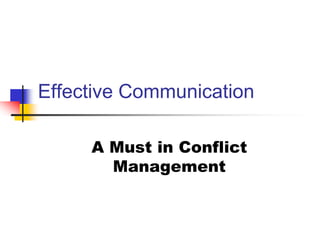Effective-Communication in the Conflict Management and Resolution
•Als PPT, PDF herunterladen•
0 gefällt mir•8 views
Ways on Effective Communication in Conflict Resolution and Management
Melden
Teilen
Melden
Teilen

Empfohlen
Empfohlen
Weitere ähnliche Inhalte
Ähnlich wie Effective-Communication in the Conflict Management and Resolution
Ähnlich wie Effective-Communication in the Conflict Management and Resolution (20)
BOOK 1984 MiniProject What makes a human beingOne .docx

BOOK 1984 MiniProject What makes a human beingOne .docx
Founder Communication Workshop April 2016 (500 Startups)

Founder Communication Workshop April 2016 (500 Startups)
Importance of Communication for Healthy Relationships

Importance of Communication for Healthy Relationships
You have already looked at your communication from your own perspect

You have already looked at your communication from your own perspect
You have already looked at your communication from your own pers.docx

You have already looked at your communication from your own pers.docx
You have already looked at your communication from your own perspect.docx

You have already looked at your communication from your own perspect.docx
Kürzlich hochgeladen
Kürzlich hochgeladen (7)
KING VISHNU BHAGWANON KA BHAGWAN PARAMATMONKA PARATOMIC PARAMANU KASARVAMANVA...

KING VISHNU BHAGWANON KA BHAGWAN PARAMATMONKA PARATOMIC PARAMANU KASARVAMANVA...
Textile Waste In India/managing-textile-waste-in-India

Textile Waste In India/managing-textile-waste-in-India
Effective-Communication in the Conflict Management and Resolution
- 1. Effective Communication A Must in Conflict Management
- 2. Two Aspects of Communication that are very important in conflict resolution or management … Ability to understand (not necessarily to agree with) the viewpoints or positions of the other party Ability to effectively express & assert oneself - needs, viewpoints - feelings, feedback - proposed solution
- 3. COMMON BLOCKS TO EFFECTIVE COMMUNICATION preoccupation emotional block hostility charisma of the speaker hidden agenda simple inarticulateness culturally-determined verbal patterns physical environment defensiveness status
- 4. Assertiveness the ability to clearly communicate one’s opinions, needs, wants, interests, feelings, etc. to another in a non-defensive and non- threatening way
- 5. Parts of an Assertion Message Description of the PROBLEM – specific behavior or statement(written or verbal), policy, etc. that is the subject of the discussion. (Validate with the other party your understanding of the problem). Description of your ASSESSMENT – i.e. specific consequences of the behavior or statement; Description of your FEELINGS and the ROOTS OF YOUR FEELINGS in relation to or arising out of the described problem; Presentation of your PROPOSAL(S) on how to resolve or manage the problem.
- 6. Components of Non-violent communication 1.Separate observation from evaluation Mixed Observation and Evaluation Observation separate from Evaluation Celso is a poor basketball player. Celso has not scored a goal in 10 games. Because of this, the coach is thinking of looking for a replacement. Mario procrastinates. Mario only studied for exams the night before. Because of this, he got very low grades in the exams.
- 7. Components of Non-violent communication 2. Express your feeling about your observation; separate this feeling from your assessment of yourself and of others. X I feel inadequate as a guitar player. / I feel frustrated about myself as a guitar player. X I feel ignored. / I feel hurt when I thought you ignored me during our meeting last Tuesday.
- 8. Components of Non-violent communication 3. Acknowledge the roots of your feelings, which are your own needs (e.g. I feel… because I need…) X “It really infuriates me when spelling mistakes appear in our public brochures. That bugs me a lot.” / “I feel really infuriated when spelling mistakes like that appear in our public brochures because I want our company to project a professional image.” X “I feel angry because the supervisor broke her promise.” / “I feel angry that the supervisor broke her promise because I was counting on getting that long weekend to visit my brother.”
- 9. Components of Non-violent communication 4. Give proposals in a non-threatening and non-demanding way: * Be conscious of our proposals and on how we, verbally and non-verbally, say it; * Use “I messages” in giving proposals. * Actively listen to the reaction of the other party to our proposal, and if necessary probe on their thoughts and feelings.
- 10. EFFECTIVE COMMUNICATION ACTIVE LISTENING is the CAPABILITY of one person to DEMONSTRATE and PROVE his/her UNDERSTANDING of the SUBSTANTIVE and EMOTIONAL messages of the speaker Why Active listening? • helps build/maintain rapport and trust • helps gather data • help check perceptions and filters • helps the speaker clarify and develop his/her ideas
- 11. HOW? • use conducive listening posture • appropriate eye contact • paraphrase or repeat in your own words the messages of the speaker • reflect the speaker’s core feeling • ask clarifying question • give statements of understanding • ask or welcome clarifications and correction • summarize the speaker’s core messages ACTIVE LISTENING Avoid! •confuse listening with agreeing •mix listening with evaluating •assume responsibility for what is being represented
- 12. • “So you think …” • “You feel _____ because _____” • “It sounds like … “ • “Let me see if I understand. As you see it… “ • Then the issue is …” • “From your point of view …“ ACTIVE LISTENING Examples of statements to demonstrate understanding “Did I get you right?” • To check the correctness of your understanding after saying how you understood the message of the speaker
- 13. Probes are STATEMENTS or QUESTIONS designed to ELICIT RELEVANT DATA from another person WHY PROBE? • get more information/data • clarify other person’s feelings • clarify other person’s thinking • test assumptions
- 14. HOW ? • ask open ended questions (i.e. what, why, how, where, when, who) • ask one question at a time • give time to answer • reinforce answers verbally and/or with body language Avoid! • confuse probes with leading question probing question: What have you done to solve your problems? leading question: What have you done to win her back? • long silences